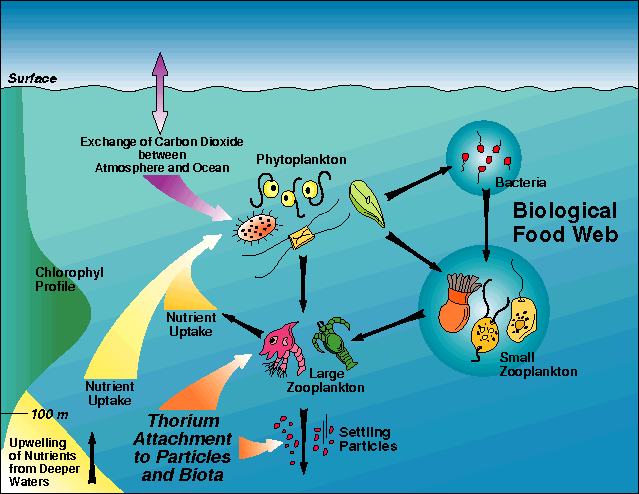Upper Ocean Export derived from 234Th: Introduction and Overview

Thorium-234 (half-life = 24.1 days) was first measured in the oceans in the late 1960's by Bhat et al. when it was shown that 234Th concentrations, or activities, were lower near the continental margins and higher offshore. Thorium-234 is produced in the oceans via the decay of its long-lived and highly soluble "parent", 238U. The activities of these two radionculides reach secular equilibrium (i.e. are identical) at relatively shallow depths of 100-200m. Since 234Th chemistry dictates that it is highly particle-reactive, and hence sticks to all particle surfaces, the loss of 234Th from surface waters is a direct indication of the removal rate of material on sinking particles from the upper ocean. The link between biological processes in the upper ocean and the extent of 234Th removal was first clearly demonstrated in a series of papers by Coale and Bruland in the mid-80's, who proposed that a relationship existed between 234Th removal rates and primary and new production in the open ocean.
Though we have been working with radionuclides for a much longer time, the Café Thorium had its origin with the US Joint Global Ocean Flux Program (JGOFS). In 1988 we took part in the North Atlantic Bloom Experiment (NABE) in collaboration with Drs. Bacon and Livingston at WHOI and Cochran at the State Univ. of New York, Stony Brook. During this study a clear relationship was found between the onset of the spring phytoplankton bloom, the subsequent drawdown of nutrients and CO2, and the net removal of 234Th (Buesseler et al., 1992 in CV). From the 234Th data one could reliably estimate 234Th particle fluxes (essentially from the difference between 234Th production and decay rates). Furthermore, and fundamentally more interesting and new to biogeochemical studies, is that by measuring the ratio of particulate organic carbon (or PON) to 234Th on sinking particles, we showed that it is possible to empirically determine the export fluxes of POC and associated elements.
After the North Atlantic, the Café Thorium jumped into high gear, and we have now collected samples over much of the world's oceans on cruises totaling a couple years at sea! For more information and specific results from these studies, and for updates on work in progress, explore the links under PROJECTS.
To learn more about radioactivity in the ocean in general see these lectures published by Ken & colleagues as a group called RiO5.